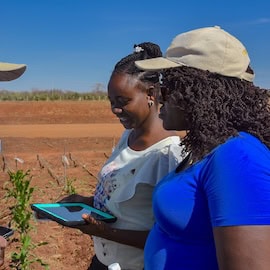Startups operating at the nexus of climate and agriculture in Africa have attracted just over $1 billion in venture funding over the past decade, according to data from AgBase (a business intelligence platform hosted by Briter and Mercy Corps AgriFin providing real-time insights on AgTech and FoodTech in emerging markets). This represents nearly two-thirds of all capital flowing to AgTech ventures, and just under one-quarter of the continent’s ClimateTech funding.
However, the “Landscape of Climate Finance for Agrifood Systems 2025” report by Climate Policy Initiative (CPI) shows that venture funding accounts for just a modest amount of total climate financing for agri-food systems in Africa — far below what’s needed to help close the estimated global shortfall of over $1 trillion in annual funding needed to align these systems with the climate-focused SDGs by 2030.
But beneath these headline figures lies a more nuanced story: Though venture funding represents a small slice of overall agri-food funding, it has an outsized role to play in driving technological adoption and impact across agri-food systems in Africa and other emerging markets.
Where does venture funding really fit?
The CPI report shows that technological breakthroughs have significantly shaped agri-food financing in emerging markets. Globally, over a third of all climate financing for agri-food systems has gone into one technology: solar-PV systems (agrivoltaics). While most of this volume is concentrated in Asia, Briter data shows that solar-PV and battery storage solutions account for nearly 80% of all funding to ClimateTech ventures in Africa.
Across the continent, ventures like SunCulture, Victory Farms and Pula have demonstrated how technology, venture funding and concessional financing can be combined to unlock solutions that have become game changers across a range of agricultural settings — from powering irrigation systems on smallholder farms, to providing energy to protect off-grid farms and cold storage facilities against increasing climate risk. Venture funding can fill critical financing gaps where technological and business model risks are too high for traditional financiers and concessional funders to address, but where getting innovations to market is critical for long-term impact.
It’s not just startups that are driving this innovation: Corporates in Africa and beyond are also embedding new technologies into their offerings. Multinationals like OCP and Yara International have launched corporate venture arms focused on soil nutrition, regenerative practices and other pillars of sustainable agriculture. The CPI report notes that global corporate climate financing for agri-food systems rose nearly tenfold from 2019/20 to 2021/22.
Why is AgTech venture funding losing momentum?
However, despite the role venture funding can play in supporting the growth of innovative AgTech startups, this funding has declined in Africa since the high-water mark recorded in 2022. Our latest “State of AgTech Investment in Africa 2024” report shows that annual funding to African AgTech ventures has fallen to around $200 million a year, less than half the $500 million raised in 2022.
Source: Briter Intelligence, AgBase 2024
As venture funding loses momentum in Africa, several risks to the AgTech ecosystem are emerging:
- Declining commercial interest: Commercial funders accounted for nearly 60% of all African AgTech deals in 2021, but made up just over a third of all deals in 2024. And even this likely overestimates commercial interest, as many of these commercial funders source their capital from concessional funders. Commercial funders, particularly venture capitalists, increasingly question whether these AgTech startups are sufficiently “backable.” At the same time, while concessional funders are stepping in, pressure on traditional donor programmes to cut funding is mounting. In addition to the disruptions caused by the shutdown of USAID, Germany’s BMZ, Sweden’s Sida and the UK’s FCDO have all signalled deep official development assistance (ODA) cuts in their 2025 budgets, raising the prospect that concessional funds could dry up just as commercial money retreats. Any donor capital that remains will therefore need to serve as a temporary, catalytic bridge, taking on more risk in the next few years to crowd in private investors rather than substituting for them.
- Gaps in funding technological breakthroughs: Scaling local science and innovation is another major challenge. From new seed varieties to seaweed cultivation, alternative proteins and carbon sequestration, scientific breakthroughs struggle to reach markets without flexible early-stage capital. AgBase data shows venture funds such as Catalyst Fund, Mercy Corps Ventures and Equator VC have played a vital role by deploying $250,000 to $1 million tickets into unproven models — an area where most public and private funders hesitate. Without such funding, we risk stalling the pipeline of breakthrough AgTech solutions.
- Struggles balancing impact and sustainability: Last, but probably most importantly, is the ongoing tension between achieving impact and building sustainable business models. Agriculture startups are already challenging to get off the ground, and targeting smallholder farmers — who are the hardest to reach and least able to pay — makes it even harder. Yet in markets like Kenya and Nigeria, AgBase data shows that nearly 90% of AgTech funding has gone toward smallholder-focused solutions. Many of these startups struggle to raise commercial follow-on capital or achieve sustainable scale. With capital scarce, prioritising these startups skews risks, undermining long-term ecosystem health and investor interest in favour of short-term impact gains.
How can we rebuild a better AgTech funding model?
Declining commercial interest, gaps in funding, and struggles balancing impact and financial sustainability are early warning signs that suggest there is a need to rebuild a better AgTech funding model in Africa and other emerging markets. And these warning signs are now shining brighter as the deep ODA cuts planned by several big bilateral donors could reduce or eliminate the concessional capital many ventures rely on just as venture cheques become scarce.
We still have more questions than answers, but three priorities can steer the discussion while this window of concessional capital is still open:
- How do we rebalance the role of concessional funders? Concessional funding plays a central role in AgTech funding for now, but how can remaining donor dollars shoulder more early-stage risk for the next two to three years, crowding in private investors rather than substituting for them?
- How do we build genuine risk-taking funding models? Blended finance works well for proven, bankable ventures. But what will it take to create funding models that don’t rely on concessional funds and can still support early-stage, untested solutions and create pathways for venture funding to bring them to market?
- How do we reframe smallholder impact for long-term resilience? Does focusing almost exclusively on smallholder farmers drive meaningful sector-wide progress, or could it inadvertently constrain innovation and limit commercial funding? Would a broader investment approach ultimately deliver more sustainable impact for smallholders in the long run?
These questions are not easy, but they are increasingly guiding our work. This month the FCDO, AgBase and CPI will be hosting an event on Accelerating Agrifood Innovation and Investment at London Climate Action Week. Later this year, Briter will deepen this research in partnership with Mercy Corps AgriFin and ISF Advisors, expanding our focus beyond Africa to track these trends across emerging markets more broadly. We will be sharing findings at the Mercy Corps Agrifin Learning Event in Nairobi and at the World AgriTech Innovation Summit in Dubai.
If you would like to help shape this conversation or contribute insights, we encourage you to reach out to us: You can contact David Saunders at [email protected], and Ludovica Fioravanti at [email protected].
David Saunders is Director of Strategy and Growth at Briter and the Programme Lead for AgBase; Ludovica Fioravanti is the Marketing and Communications Lead at Briter; Harsha Vishnumolakala is an Analyst at CPI’s London office.
Photo credit: Jerome Bossuet/CIMMYT
Publisher: Source link






